Users’ Rating (Click a star to rate this gun.)
Summary: Walt Rauch’s review of and rating for the North American Arms Sidewinder revolver, including a range report, photos, pricing, specs, user ratings and user comments. (Click here to see all of Rauch’s handgun reviews.)
Editor’s Review
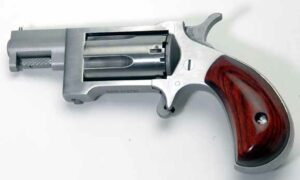
There’s a truism that it’s better to have a gun and not need it than to not have a gun and need it. Also true: Concealing your carry handgun brings certain demands, not the least of which is simply effectively concealing it. In fact, in some circumstances, it must be completely undetectable, even to the trained observer.
Solutions range from not carrying at all to risking discovery or using a smaller handgun. Each choice offers its own rewards or penalties, which run from being embarrassed, getting arrested or being armed with a gun many consider ineffective for defense. But it’s your life and you should decide what’s best for you based on your needs.
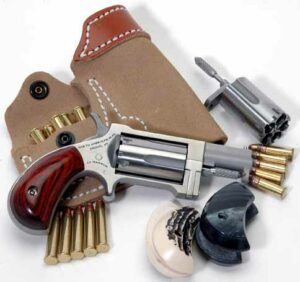
Well worth considering: the North American Arms (NAA) Sidewinder revolver, model NAA-SWC. This mini revolver is chambered for .22 WMR with a conversion cylinder available in .22 LR. The Sidewinder may well be considered a sub-subcompact or miniature handgun because it’s one of the smallest concealable, cartridge-firing handguns available.
NAA offers roughly 70 variations of this concept, with its revolvers chambered in .22 Short, LR and WMR. (NAA also sells black powder versions and sub-subcompact semi-autos, topics for other reviews.) The Sidewinder examined here is the company’s latest iteration.
The Details
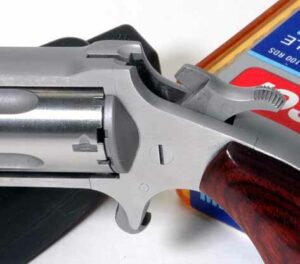
The NAA-SWC Sidewinder is a five-shot, stainless-steel, single-action revolver. It features two-piece, laminated wood, bird’s head grips; a bead front sight screwed into its barrel; and a dished-out square-notch rear sight in its top strap. The Sidewinder differs from other NAA revolvers in that it features a swing-out cylinder held in by a cylinder crane (more on this later).
The Sidewinder is diminutive, with a height of 2.875″, a width of 1.0625″, a barrel length of 1″ and weight of just 6.7 oz. The revolver features a machine-checkered spur hammer and checkered trigger, which doesn’t include a trigger guard. Its trigger pull weight measures 4 lbs.
To open the cylinder for loading or unloading, pull the hammer back to its first notch, which is the half-cock notch. With muzzle directed away from you, pull the cylinder pin fully forward about 1/8″ against its retention tab. This action fully compresses its spring-loaded retention plunger. While holding the plunger in this manner, push the cylinder to the right. It pivots on its crane to about an 80-degree angle to the frame. Remove live or empty cartridges by pushing the cylinder pin rearward, which raises the extractor about 1/8″—enough for you to finger the cartridges out of the cylinder.
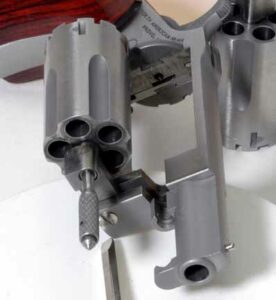
When you close the cylinder after loading or unloading, make sure the knurled pin doesn’t interfere with or overlap the pin-compression tab. The spring-loaded retaining nub will compress as the cylinder returns to the frame. It’s best to press firmly on the cylinder crane until the cylinder is completely within the frame and the knurled pin is fully seated in the retaining slot.
To change a cylinder, remove the straight-slot screw in the cylinder crane, then remove the cylinder and its crane. The front of the .22 LR cylinder is helpfully marked with a stamped “L,” while the .22 WMR cylinder remains unmarked. Reverse this process for re-installation.
You can safely carry NAA revolvers fully loaded—the Sidewinder included—if you use the cylinder safety slots. Note: You must never carry the revolver in the half-cock position because the purpose of this cocking position is to prevent the gun from firing if the hammer slips out from beneath your finger when cocking the pistol.
To use the cylinder safety slots, I’ll paraphrase the instruction manual: With the muzzle directed away from you, pull the hammer back to the first point (just beyond half-cock), where the cylinder rotates freely. When the large and small slots on the cylinder align with corresponding large and small cuts on the recoil shield, a cylinder safety slot will be located directly underneath the hammer. With your thumb controlling the hammer, fully depress and hold the trigger until you lower the hammer so that it fully rests against the frame. The hammer’s firing pin should now be engaged in a safety slot. To verify this, attempt to rotate the cylinder and ensure it barely rotates in either direction. If so, you can now carry it safely.
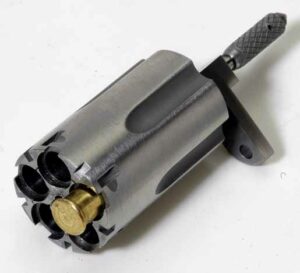
The instruction book includes photos supplementing the printed instructions for loading, unloading and using the safety cylinder (thank goodness!). And there’s a video showing the entire process on the NAA Web site. All prove quite helpful. I did find the process difficult to perform initially but got the hang of it after a few repetitions. Lubricating everything before you start helps.
Finally, for this review NAA sent me several nice accessories, including optional imitation stag and pearl grips; a boot grip, which changes the round grip to a square and longer grip; pocket and belt holsters; and a soft, lockable carrying pouch.
Range Report
When I met with Ted Murphy and AJ Stuart at the Lower Providence Rod and Gun Club range in Oaks, Pa., for shooting and evaluation of the NAA Sidewinder, I didn’t expect to find much if anything different from last year’s effort by the three of us when we shot the NAA 22MS model. Back then, we found it easy to make effective torso and head shots at a one- or two-arms lengths. This time, one-handed shooting at 5 and 7 yards had all our shots again grouping within the 6″ diameter center of a Warren IDPA training target, but with some new wrinkles.
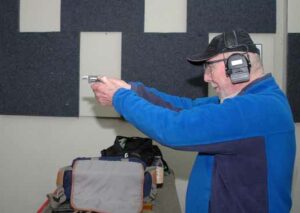
Murphy went first, pointing out how he much preferred the Sidewinder’s round bead front sight over the ramped front sight of the 22MS. He found that now he was picking up the bead quicker and this helped him make faster center hits. (As an aside, while the notion of discussing sights on a miniature gun might seem to be overkill, this comment is revealing in that it shows his well-ingrained shooting skills.)
Stuart then chimed in, demonstrating how he established an effective two-hand grip. He was placing his support-hand thumb on the frame behind the hammer and applying some pressure. This also helps in faster hammer cocking. (Again, more ingrained shooting skills were applied.) Murphy and Stuart both then were able to rap out quick cylinders full of .22s. (Doing this is probably “old hat” to cowboy action shooters, of course!)
We shot the same assortment of ammo as we did previously with the NAA 22MS, with Murphy now firing much more of the .22 LR ammo. (I suspect there’s a Sidewinder in his future.) There were no misfires or malfunctions, and, although cases began to need help to extract, they did come out with little effort.
And no, we did not shoot .22 LR in the .22 WMR cylinder. Don’t! The .22 WMR case is larger than the .22 LR’s, so the .22 LR round will fit and fire, but the empty .22LR case can also swell or even burst when fired. Why gamble unless you’re facing a real threat?
I shot a few accuracy groups at 7 yards and achieved a 2.75″ group with .22LR and a 4.75″ group with .22 WMR. However, because the Sidewinder seems to demand humanoid targets placed at confrontational distances—in your face, so to speak—that’s mostly what we did. Head shots and good body hits were the norm, with the only limitations being our manual dexterity in manipulating the gun.
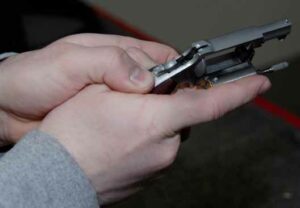
I did find that switching to the optional longer, square-butt boot grip made shooting the Sidewinder much easier. I also performed some pocket draw and fire using a DeSantis Magnum pocket holster (sold by NAA). The holster stayed put and the gun’s hammer didn’t catch on anything—I found I either put my whole hand around the gun in my pocket or put my thumb on the hammer, as in anticipation of cocking it.
Here’s the ballistic data I recorded for both calibers in the Sidewinder. I obtained these results firing over a Pro‑Chrono Crony chronograph at 300 feet above sea level with the ambient temperature at 58 degrees F. These numbers represent five‑shot averages at 10 feet:
Ammunition: .22 WMR
- Hornady 30-grain V-MAX: 961 fps
- CCI Maxi-Mag 40-grain JHP: 941 fps
- Federal 50-grain JHP: 679 fps
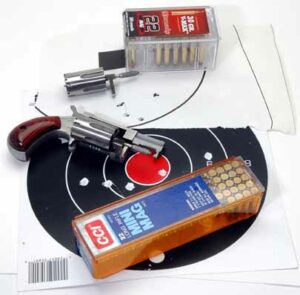
The author’s target results. The upper group measured 2.75″ with .22 LR. The lower measured 4.75″ group and was fired using .22 WMR.
Ammunition: .22 LR
- CCI Mini-Mag 36-grain HP: 707 fps
- Remington Target 40-grain LRN: 628 fps
- Winchester Super-X 40-grain PRN: 665 fps
Important: A supplemental sheet NAA included with the gun dated May 17, 2004, features a warning paraphrased as follows: NAA “recently learned that the use of PMC .22 caliber ammunition (both .22 WMR and .22 LR) may affect the performance of its revolvers. Specifically, NAA has learned of a phenomenon in which an inadvertent, double-discharge (i.e., two rounds simultaneously discharging, one aligned with the barrel and the other out of battery) may occur when PMC brand ammunition is used in NAA .22 revolvers…”
Ouch!
Final Thoughts
I’ve previously written how an NAA revolver in .22 caliber should be viewed as either a back-up for deep cover use or as a last-ditch weapon when you have nothing else left with which to defend yourself. The .22 WMR is the more potent of the two cartridges, so you might as well choose it for either task. I’ve also said that although an NAA .22 caliber revolver is suitable for concealed carry, its size, caliber and method of operation aren’t optimal for first-line defense. And that for me, it’s almost too small to hold, let alone get a good firing grip. And, cocking the pistol for every shot is not the quickest method of launching multiple rounds.
But as the saying goes, the first rule of a gunfight is to have a gun. You must, of course, know that particular gun’s limitations, but the .22 WMR’s ballistics are nothing to sneer at, with a 25-45-grain bullet traveling out of the Sidewinder’s 1″ barrel just shy of 1,000 fps.
Plus, any number of outdoorsmen use .22 WMR (and even .22 LR), albeit with correct bullet placement, to humanely dispatch all sizes of animals. And, no one wants to leak; that is, to suffer the creation of bullet holes in their body. The Sidewinder allows creating many and accurate leaks quickly by just about anyone who can pull a trigger.
The Sidewinder thus fits the criteria of a handgun you can secrete somewhere on your person for use only when you have nothing else left with which to defend yourself. Therefore, it’s one good answer for those who want or need an “always” handgun.
The Sidewinder and conversion cylinder retail for $389. Small price if you need small.
 Walt Rauch received a BS degree from Carnegie Tech and completed service as a Special Agent in U.S. Army Intelligence. Rauch was a U.S. Secret Service Special Agent and a Philadelphia, Pa., Warrant Unit Investigator. He now operates a consulting company for defense-weapon and tactical training. Rauch & Company services include expert witness testimony on firearms use and tactics.
Walt Rauch received a BS degree from Carnegie Tech and completed service as a Special Agent in U.S. Army Intelligence. Rauch was a U.S. Secret Service Special Agent and a Philadelphia, Pa., Warrant Unit Investigator. He now operates a consulting company for defense-weapon and tactical training. Rauch & Company services include expert witness testimony on firearms use and tactics.
Rauch is also a writer and lecturer in the firearms field. He’s published in national and international publications including InterMedia’s Handguns, several Harris Publications specialty magazines, Police and Security News and Cibles (France). He is the author of a book on self-defense, Real-World Survival! What Has Worked For Me, as well as Practically Speaking, a comprehensive guide to IDPA defensive pistol shooting.
The Specs
| Caliber | Capacity | OAL | BBL | WI | HI | WT |
| .22 WMR, .22 LR | 5 | 5″ | 1″ | 1.0625″ | 2.875″ | 6.7 oz. |
Pricing
MSRP: $349
MSRP: $389 (w/conversion assembly)

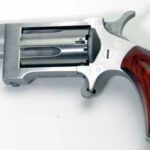
This is a great revolver for self-defense.
Sir:
Do you feel that the 2.5 inch(it may be just a ‘2’..not 100% sure). barrel Sidewinder will offer
a substantial ‘leg up’ in terms of accuracy over the 1 inch. version – or that the difference
is marginal at best?
realizing that the one-inch version is intended for up close-and-personal (arm’s reach), I was thinking that the 2/2.5 inch version might satisfy that requirement as well as be a good ‘plinker’…not sure?
thank you for your time!!!
Sincerely,
Devin Last
*SEATTLE
hi
I like your website and your articles very much
Especially your little revolver
I am French
Do you deliver to France?
What do I have to provide as a document?
My identity card and my French license?
cordially
It is a fun little gun to shoot, but if you want to plink, get something more practical that is a lot less work. A Ruger Mark I through a Mark IV is pure pleasure. Plinking with the Side Winder is just a lot of work. The fired shells swell and are hard to extract. For some reason the cylinder locks up and won’t rotate. Both times there were fired shells with one or two left to fire. The cylinder didn’t want to rotate- Wouldn’t rotate! And it was very difficult to get the cylinder to flip out. It locks up tight. My husband polished the recoil plate and the cylinder walls with super fine grit paper and smoothed any surfaces that might bind in rotation, and I will be trying it again. I have a Master mag with a 4″ barrel that is flawless….but still a lot of work at the range! My little Concealed Carry Ruger 9 shot 22 revolver is easy and bullet proof!
i have the Sidewinder with 1″ barrel and achieve nice plinking on the range at 15 feet – 10-ring shots are 30%, so i’m happy with the result (shooting ‘quiet’ LR and shorts)… i cannot speak to the previous poster’s problems regarding swelled cases, but i’d suspect crappy ammo and poor cleaning (gotta keep the gun clean, especially under the extractor)… i put several hundred rounds through my Sidewinder on its first outing, and 100 rounds of CCI shorts simply dropped out when extracted (you do have to hold the revolver properly with the barrel at 12 noon – duh!)… all in all, this is a wonderful little wheel gun… i have it with engraved boot grips and it’s a pleasure to shoot… as far as the first poster, i’d like to think the 2.5″ barrel version would be fun gun to shoot out to 25 feet with proper technique…
but folks, don’t shoot crappy ammo – shoot the good stuff…
I own the Sidewinder and love it. I installed the LaserLyte Mighty Mouse Laser grips and what a combo. I’ve concealed carried for over twenty years. S&W model 38 Air weight, Glock 27, Beretta 9mm, Ruger .45, & now the SIdewinder. I get nice head shot groups at 10 yards and it loads and unloads easy. I agree with Willie, shoot good ammo. I shoot Speer short barrel 22WMR. The hollow point is designed to expand better in the shorter barrel. You Tube has some great videos showing the effects in gelatin. The Sidewinder is easy to carry and I would have no issue using it for defense. The key to any carry gun. Practice, practice, practice.
Having carried firearms for 40 years as a police officer, this Napa sidewinder in 22 and 22 mag would be a great last resort firearm. It would be a great backup for Police just as a very last resort but most states would not allow the caliber to be carried by law enforcement. Citizens can carry it but law enforcement can’t even carry it off duty because they are not allowed to qualify with it. Being retired and giving up my certification I can carry it with my concealed weapons permit.Remember, this is a last resort. I feel safe having it on me.